Journals
The journals are the effective data recording aspect of the accounting operations
as regards the transactions conducted. In the Odoo platform, all the financial documents
associated with a company are recorded as journal entries. It is the record of transactions
ordered by date.
The journal menu in the platform can be accessed from the configuration tab of the
invoicing module.
Invoicing -> Configuration -> Accounting -> Journals.
The image of the journal’s window is depicted below.
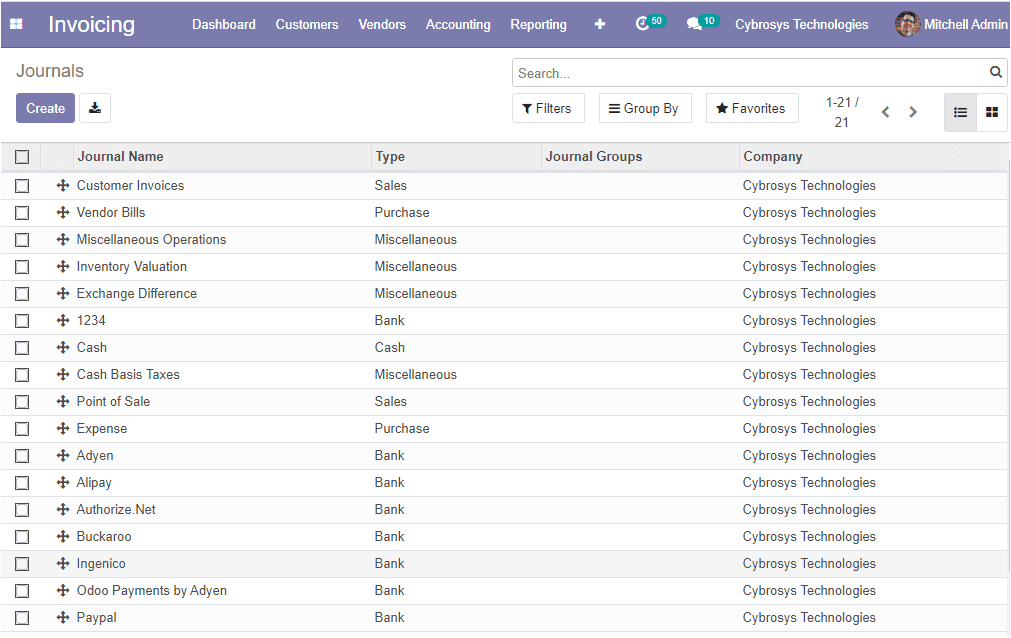
In this journal window, you can view all the journals described in the platform
along with the journal name, type, and company. You also have the provision to create
a new one by selecting the create icon. The image of the creation window is depicted
below.
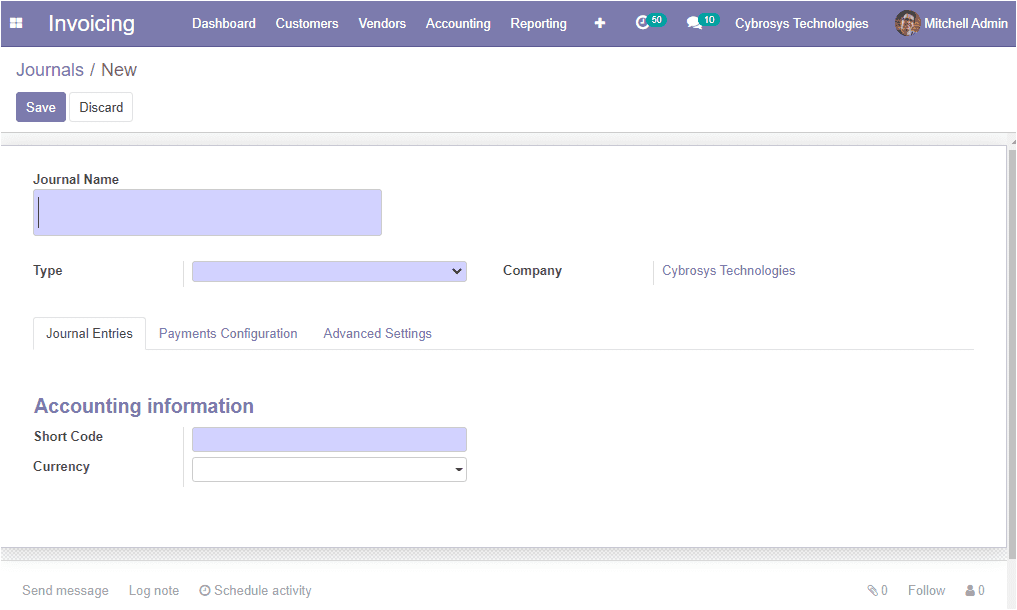
In this journal creation window, you can provide the journal name, allocate journal
type from the dropdown menu. You can select the sales for customer invoices journals
and the purchase can be selected for the vendor bills journals, select cash or bank
for journals that are used in customer or vendor payments. Additionally, you can
specify the company related to this journal.
Under the Journal Entries tab, you can allocate the accounting
information such as Shortcode which is the shorter name used for the display. The
journal entries of this journal will also be named using this prefix by default.
Also can define the Currency used to enter a statement.
Under the Advanced Settings tab, you can provide the Control -
Access information such as Allowed account types, allowed accounts. Also, you can
enable or disable the option Lock posted entries with hash. If you are enabling
this option, the accounting entry or invoice receives a hash as soon as it is posted
and cannot be modified anymore.
Now let us discuss the journal types.
Journal types
All the journal entries of this module should be configured for the operation under
the journal types defined. That means by giving a journal type on journal entries
you are specifying that the current journal comes under an accounting document.
Here in the Odoo platform, the journal type can be defined under the journal types
menu available from the configuration tab of the invoicing module.
Invoicing -> Configuration -> Accounting -> Journal groups.
The image of the journal group window is depicted below.

In the Journal group window, you can view all the journal entries defined in the
platform and you can create a new one by using the create icon available in the
window.

You can allocate the new one in the same window along with the details such as journal
group name, the excluded journals, and the company related to this operation.
As we clear on the feature Journal Types available in the platform and now let us
discuss another feature Incoterms.
Incoterms
The Incoterms are the fifteen trade terms of sales published by the International
Chamber of Commerce ( ICC ) and it is accepted worldwide in an allocation of cost
and responsibilities between the seller and the purchaser. These international commercial
terms (incoterms) can be used in both international and domestic trade contracts.
This feature can be accessed from the configuration tab of the invoicing module.
The image of the Incoterms window is depicted below where you can view all the incoterms
defined in the platform along with the name and the code.
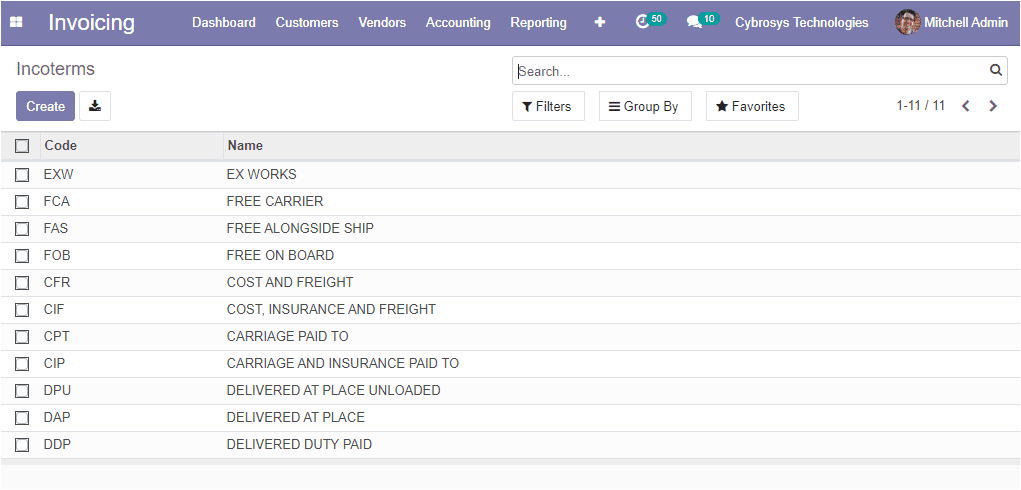
You have the provision to create a new one and this can be done in the same window
itself by clicking on the create icon.
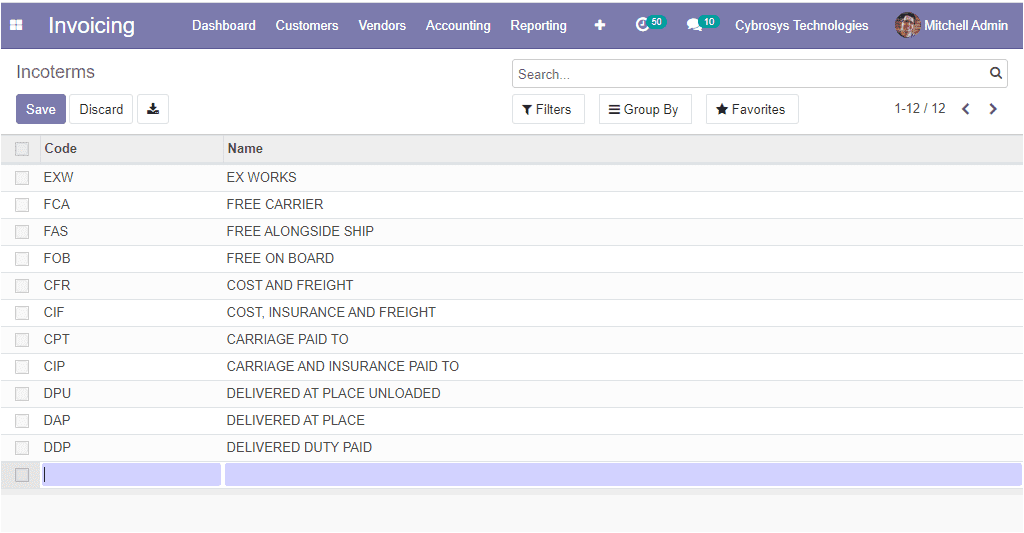
The created incoterms must be reliable for all the business operations. Now we are
clear on the incoterms in the platform and now let us discuss the configuration
of Payment terms.
Payment terms
The payment terms are the various conditions followed by the customer and the supplier
to make payments for the product and services. It can be applied to both supplier
bills and customer invoices. One of the examples for defining payment terms is to
pay 60 percent within 7 days and the remaining balance can pay within 30 days. The
Odoo platform allows you to describe the various payment terms and the menu can
be accessed from the configuration tab of the module.
Invoicing -> Configuration -> invoicing -> Payment terms.
The image of the window is depicted below.
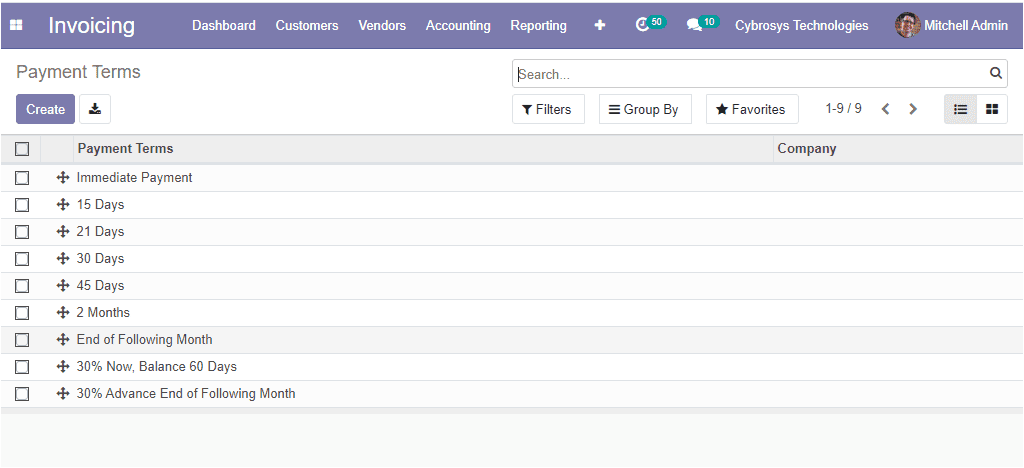
Here in this payment terms window, you can view all the described payment terms
in the platform and you can create a new one by selecting the Create
icon available.
The image of the payment terms creation window is depicted below where you can provide
a name for the payment terms and you can allocate the company where this payment
terminology should be used if you have multiple companies. The descriptions that
should be mentioned on the invoice which is the payment term explanation for the
customer can be provided in the allocated box.
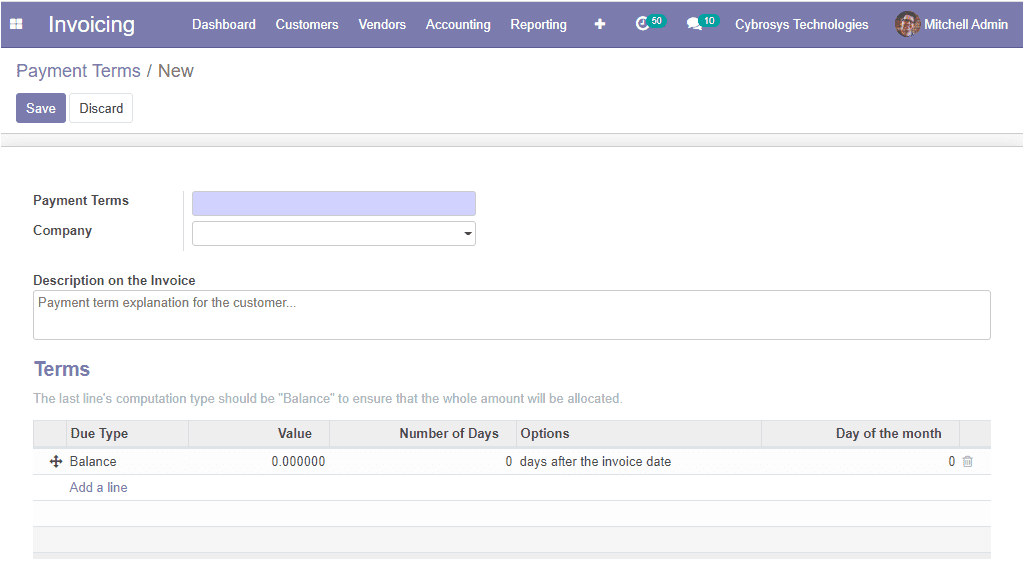
Additionally, you can define the terms by selecting the Add a line option where
you will be depicted with a new pop-up window for creating terms. In the pop-up
window, you can mention the term type. It can be allocated as balance, percentage,
or fixed amount. You can select the term type depending on your business requirements.
Moreover, the due date computation can be defined. It can be made based on the day
after the invoice date, day after the end of the invoice month, last date of the
following month, or last date of the current month, and this can be selected from
the dropdown menu available. Then you can select the save & close button to add
the terms to your payment terms window.
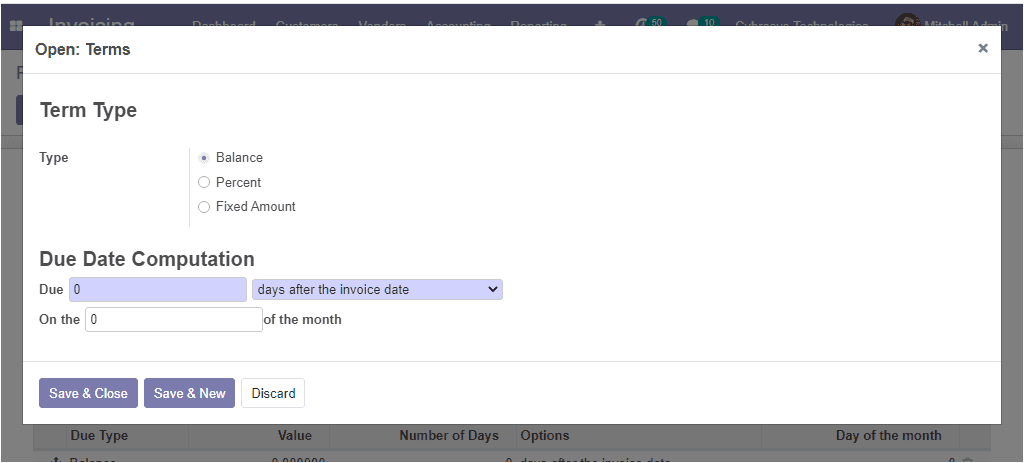
So far we were discussing the configuration of Payment terms in the platform and
now let us move on to the analytical account option available.
Analytical accounting
The analytical accounting feature in the Odoo platform can be used in business to
track and record the financial aspect of the majority of sectors inside a company
such as sales, purchase, and invoicing and the various financial aspects included
to find out where the funds of the company are being spent and are retained. The
Odoo Analytic Accounting allows you to create Analytic accounts, Analytic Tags without
creating more accounts in the Chart of accounts. This feature can be used for various
requirements such as analyzing the cost of the company, reinvoicing the time to
a customer, and analyzing the performance of a service or project.
The analytical accounting feature in the Odoo platform can only be accessed if you
enable the Analytic accounting option available under the Analytics tab of the settings
menu.
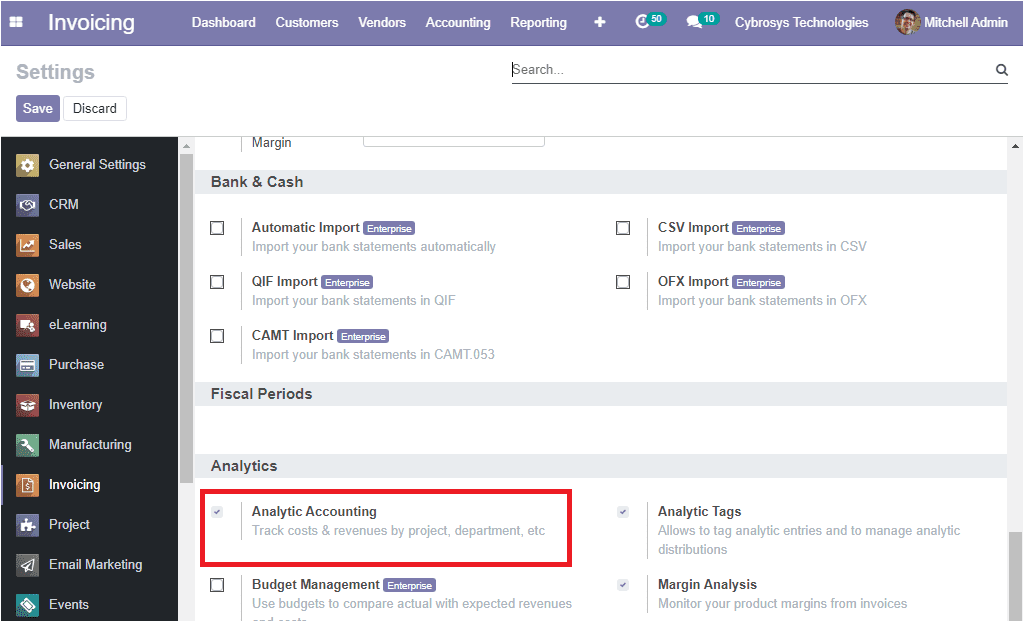
Now the analytical accounts menu can be accessed from the configuration tab of the
invoicing module as depicted in the below image.
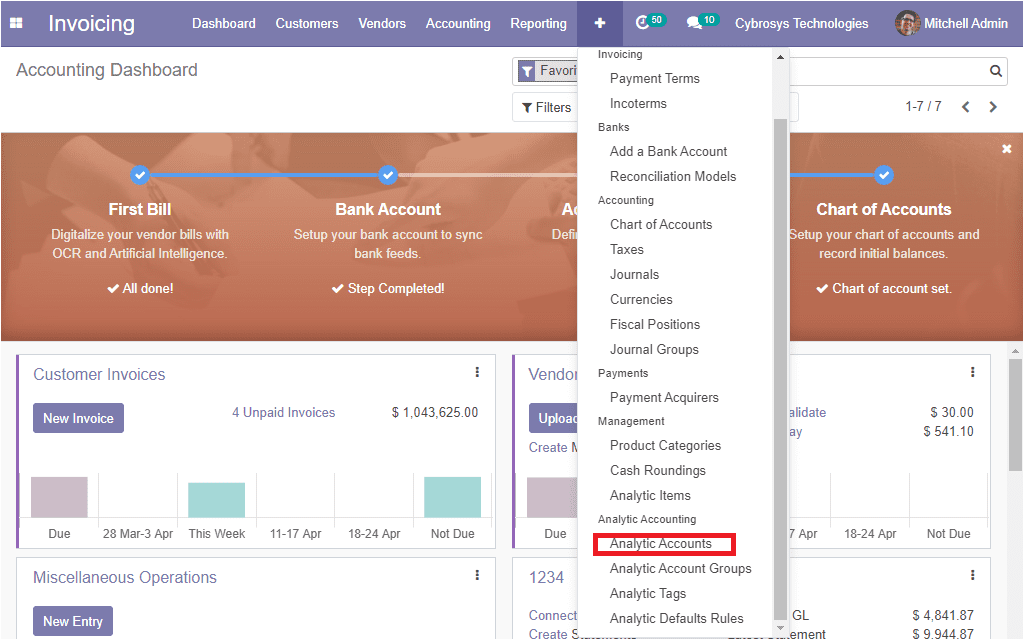
On selecting the Analytic accounts menu you will be directed to the Analytic Accounts
window as depicted below where you can view a list of all the created analytic accounts
along with the name, customer, company, debit, credit, and balance. It is possible
to edit them by selecting the edit button.
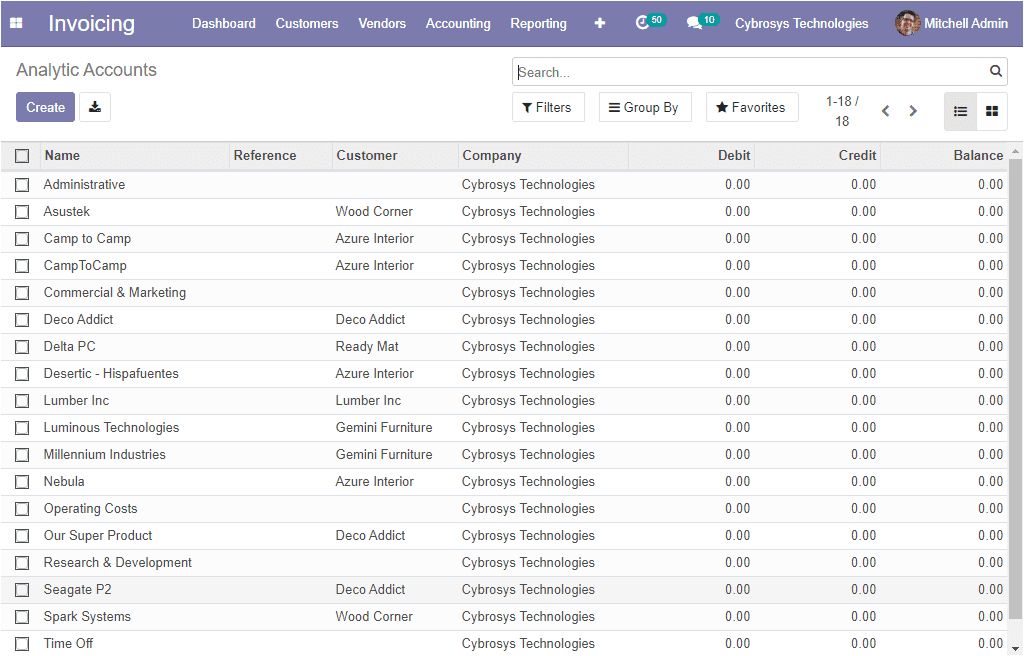
You can create a new Analytics Accounts by selecting the Create
icon available. The image of the creation window is depicted below.
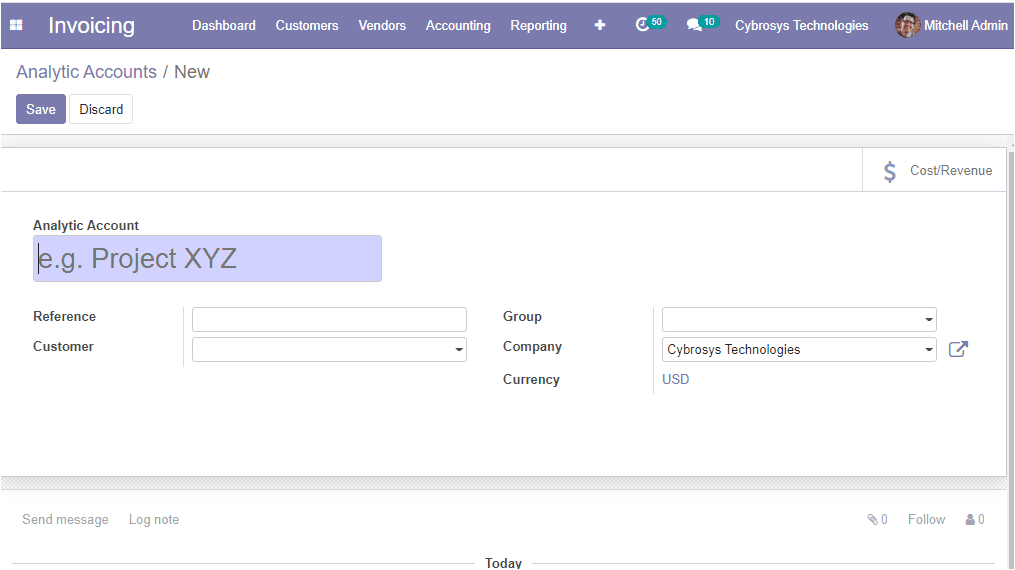
In the creation window, you can provide the name of the analytic account along with
the reference number and the customer details. Moreover, you can allocate a group,
a company related to this operation, and the currency. After providing all the fields
you can save the details by selecting the Save icon available.
So far we were discussing the Analytic Accounts window available in the platform
and now let us move on to the Analytic tag option available in the module.
Analytic Tags
In the Odoo invoicing module, you have the option Analytic tags, and the expense
and profits can be distributed among the different analytical accounts using this
feature analytic tag. The analytic tags window in the platform can be accessed from
the configuration tab of the invoicing module.
Invoicing -> Configuration -> Analytic accounting -> Analytic tags.
The image of the Analytic tags window is depicted below where you can view all the
analytic tags described in the platform.

On selecting the Create icon you can create new analytic tags and
the image of the creation window is depicted below.

Here in the creation window, you can allocate the name of the tag, enable the analytical
distribution option and specify the company.
As we are clear on the Analytic tags option available in the platform and now let
us move on to the next section.
Customer invoice to payments
In the Odoo platform, you have the provision to follow different approaches to automate
the customer invoice creation based on your business and the application you use.
Generally, draft invoices are made by the framework ( data originating from different
reports like sales orders or contracts) therefore the accounts can easily approve
or validate the draft invoice and send the solicitations in batch (by customary
mail or email).
It is possible to create customer invoices directly from the dashboard by accessing
the Invoices button available under the Customers tab.
Invoicing -> Customers -> Invoices.
The image of the window is depicted below.

On selecting the Invoices menu you will be navigated to the Invoices window where
you can view all the invoices described in the platform along with the reference
number, Customer details, Invoice date, Due date, Next activity, Company, Tax excluded,
Total amount, Status, Payment status. The image of the window is depicted below.
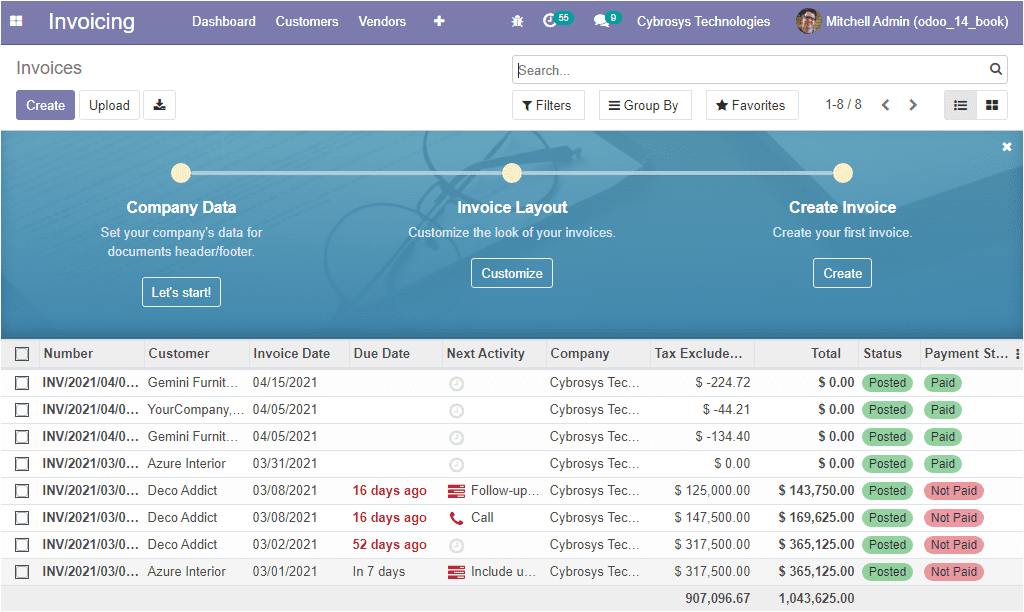
In this window, you can view a Create icon on the top left corner.
By selecting this icon you can create new invoices. The image of the creation form
is depicted below.
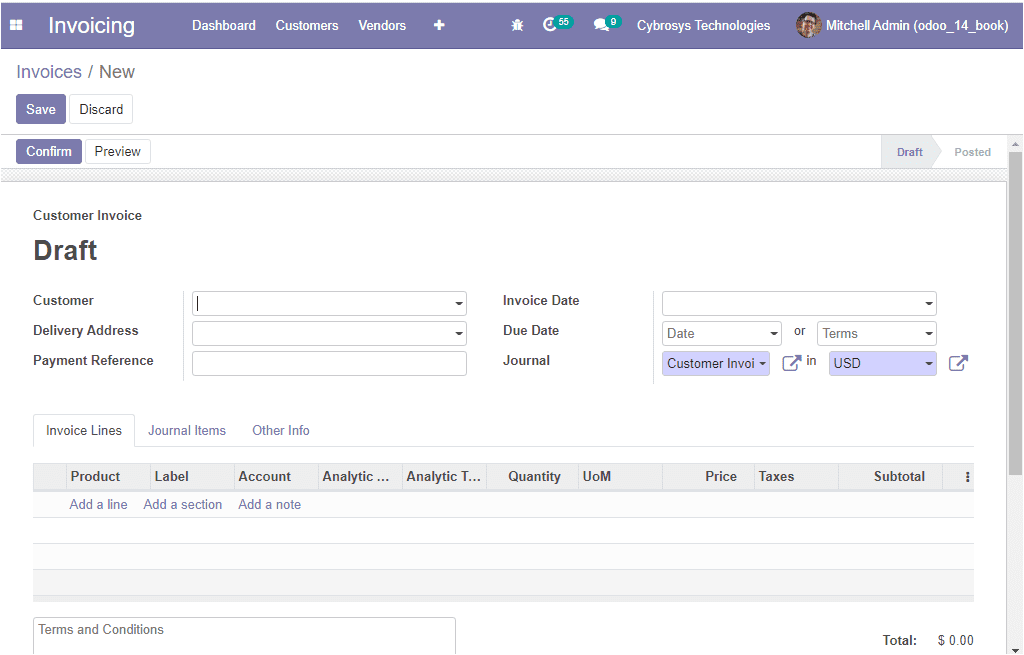
Here in this window you can allocate the Customer details using the drop-down menu
and provide the Delivery address along with the Payment Reference. Moreover, the
Invoice date, Due date, Journal can be specified under the respective field.
Under the Invoice lines tab, you can add the products which the
customer intends to buy via clicking on the Add a line option available. It is also
possible to add a section and a note by selecting the respective tab.
Moreover, you can add a journal item by selecting the Add a line option available
under the Journal Items tab.

Now let us move on to the Other Info tab available in the invoices
window. Under this tab, you can provide the Invoice, Marketing, and Accounting details.
In the Invoices field, you can allocate Customer Reference, Salesperson, Sales Team
along with the Payment QR-code and Recipient Bank. Recipient Bank is the bank account
number to which the invoice will be paid. As for the Marketing details, you can
define the type of Campaign. This is a name that helps you keep track of your different
campaign efforts like Christmas specials. Also can allocate the Medium using the
dropdown menu. It is the method of delivery such as banner, email, direct, and many
more. Moreover, you can specify the Source of the link such as the search engine,
another domain, or name of the email list, and so on. Finally, you can mention the
Accounting details such as the Company related to this journal, Incoterms, Fiscal
position using the dropdown menu.
Additionally, you can specify the Cash Rounding Method. Finally, you can check the
box near the option Post Automatically. So the entry will be automatically posted
at its date. At last, you have one more option named To check. This option means
that the user was not sure of all the related information at the time of the creation
of the move and that the move needs to be checked again. After filling in all the
required information you can select the Save button to save details. Then you can
click on the Confirm button. Now the status will change from
Draft to Posted. The image of the window is depicted
below.
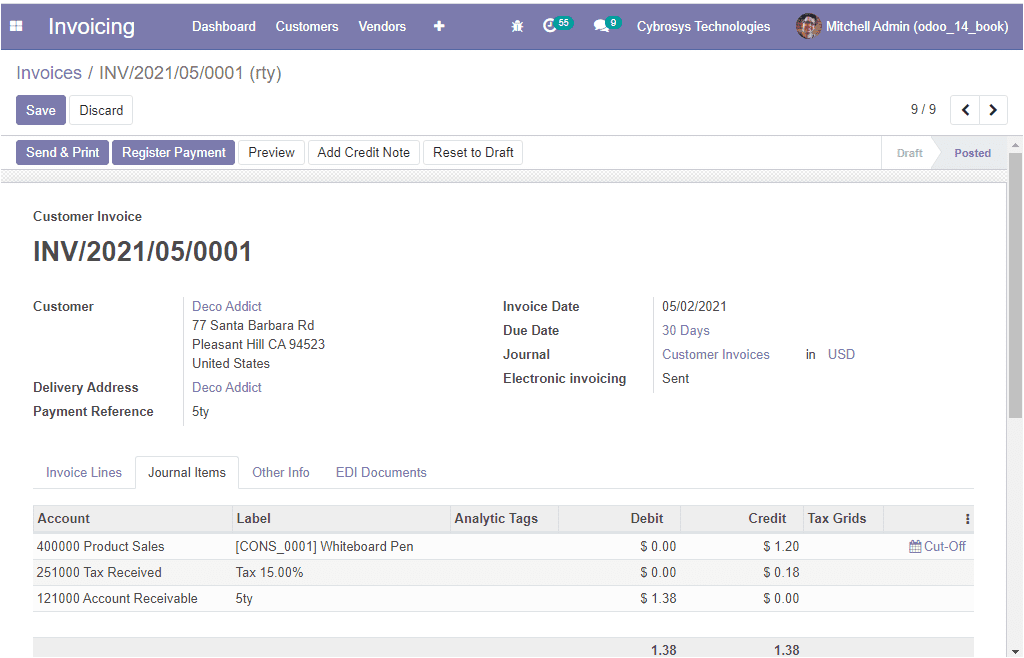
In the above window, you can view different tabs on the top window named Send
& Print, Register Payment, Preview, Add Credit Note, Reset to Draft.
If you click on the Register payment button, you will be navigated to a Register
payment window where you can describe the details. You can define the Journal, Recipient
bank account along with the Amount date, Payment Date, Memo. after entering all
the required details you can select the Create Payment icon.
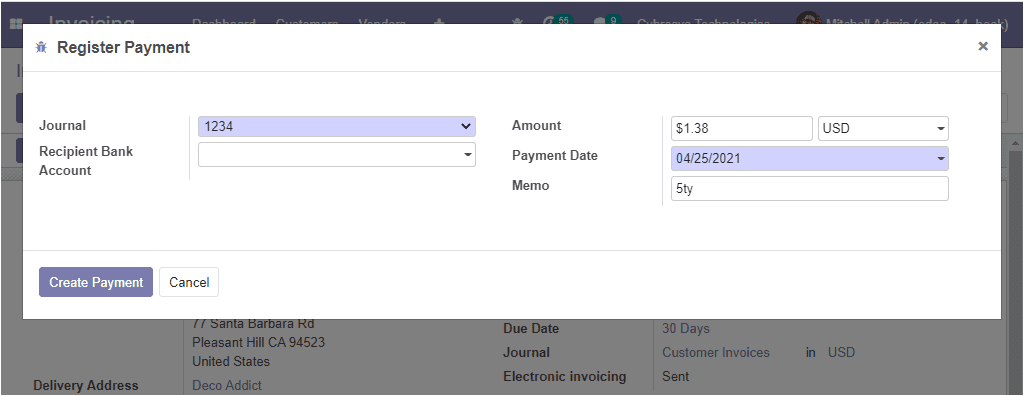
By selecting the Create Payment button you will be directed to a new window where
you can view a green tag with Paid status. This means the invoice
has been paid for. The image of the respective window is depicted below.
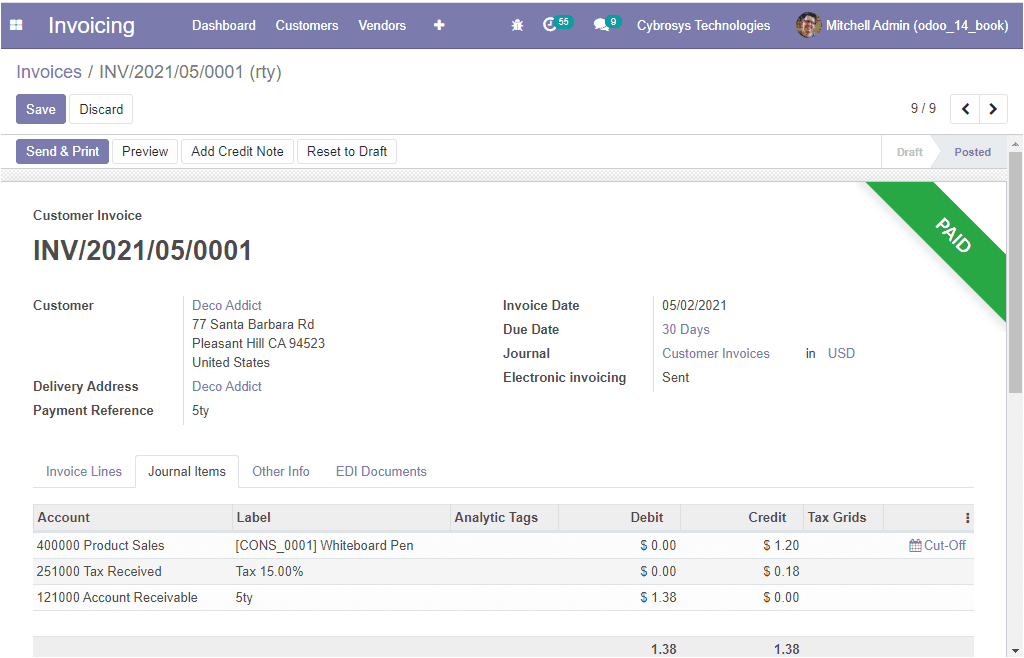
Now you can go to the Sales window of the invoicing module. It
can be accessed from the accounting tab. Here in this window, you can view the journal
entry that was automatically created for the invoice. The image of the window is
depicted below.
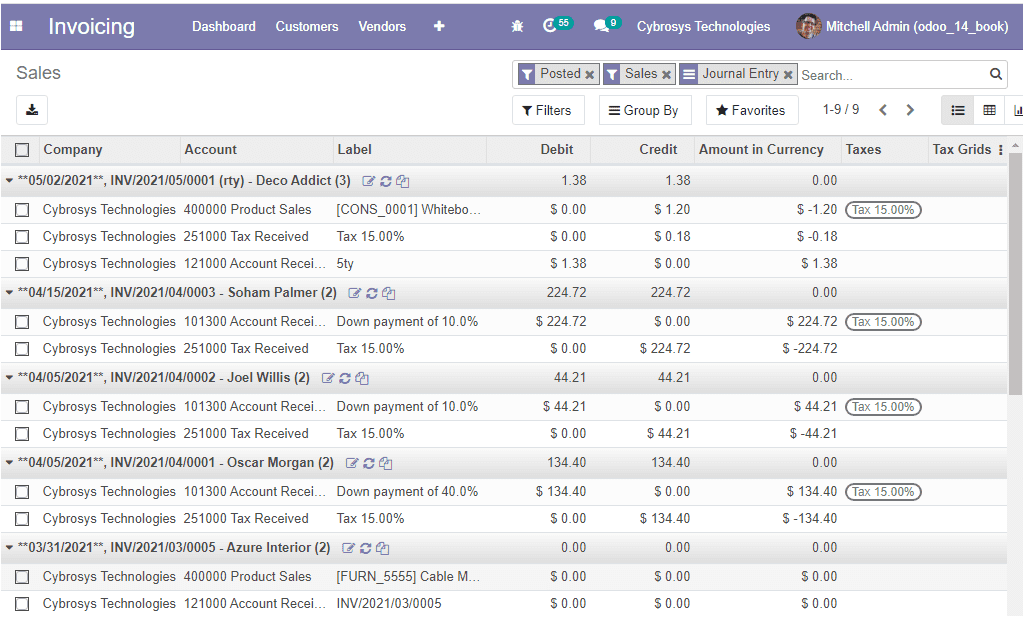
You can click on them to get the journal entry with debit and credit balanced.
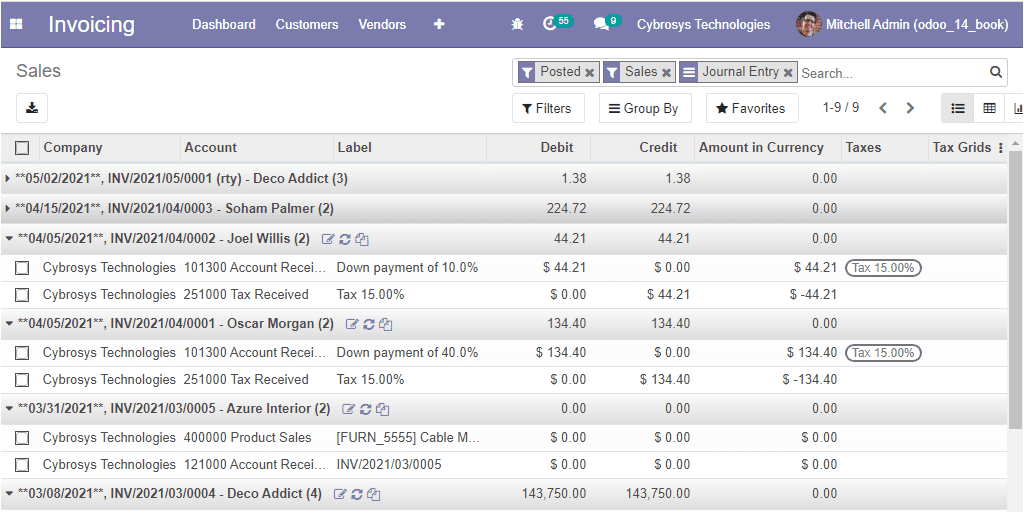
Now you can view the payment details under the Payment window available in this
module. The window can be accessed by taking the route Invoicing -> Customers
-> Payments.
The image of the window is depicted below.

Here in this window you can view the invoice payment details such as Payment Method,
Journal, Customer and Company name, Date, Number, Amount, Status, and Currency.
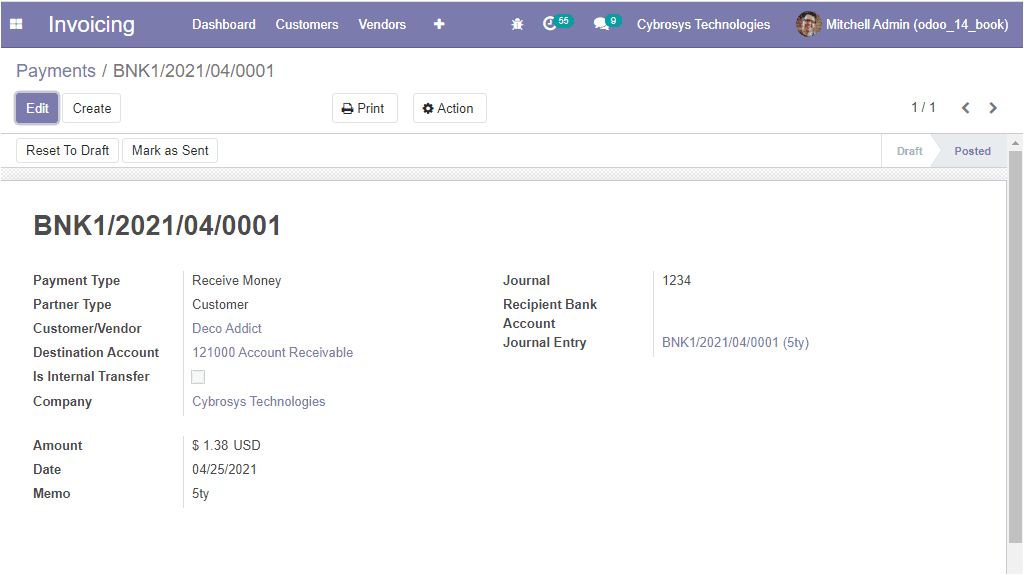
So far we were discussing the Invoice creation and Payments available in the module
and now let us discuss the feature of Cash rounding in the platform.